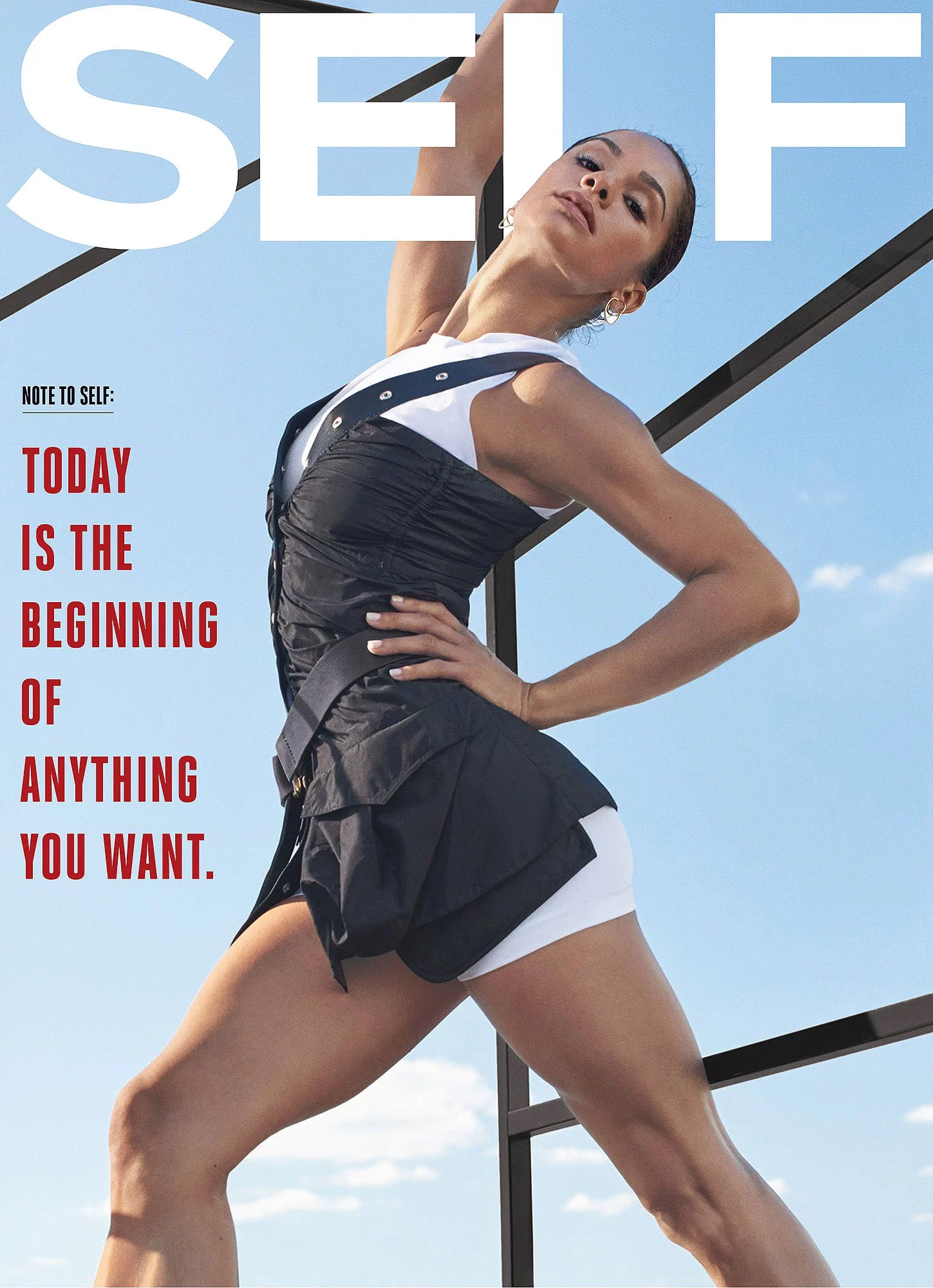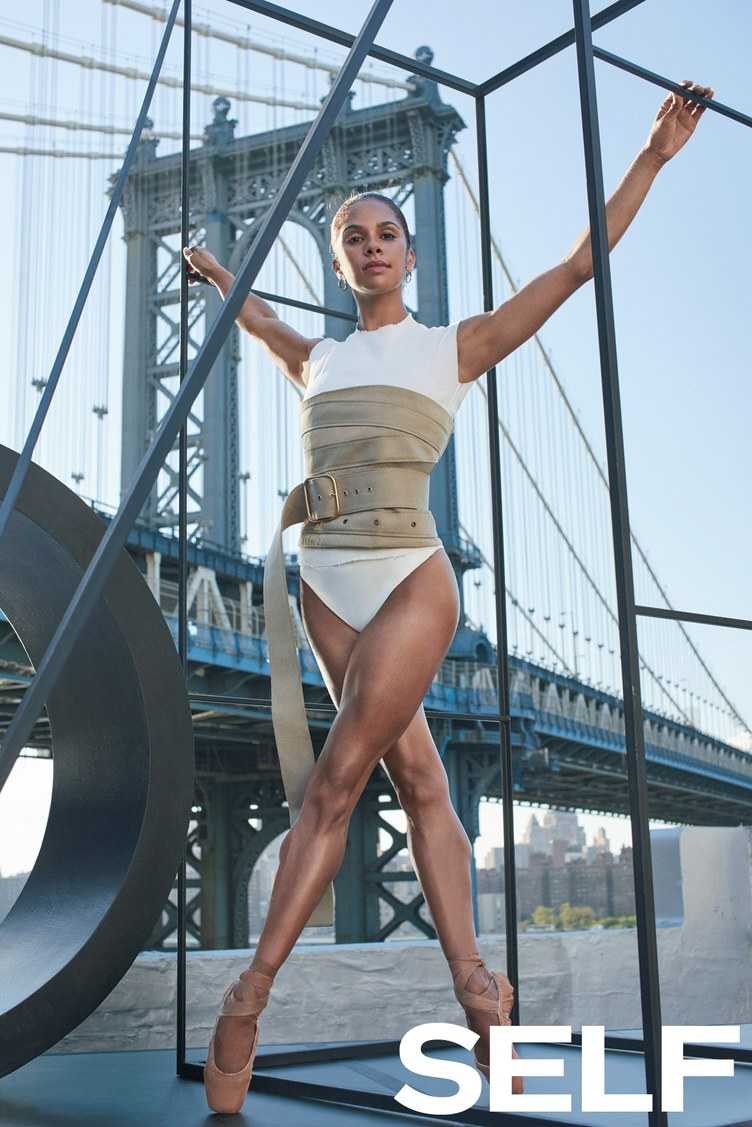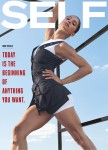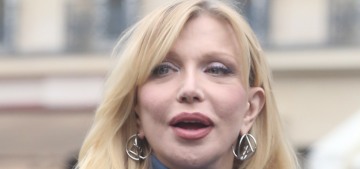Misty Copeland covers the new Self Magazine, and everything about her is to die for. She’s beautiful, her body is crazy, and her attitude is amazing. Copeland is arguably America’s most famous working ballerina, and she appears on Self because she’s playing the lead role in the American Ballet Theater’s The Nutcracker this Christmas season. Misty was ABT’s first African-American ballerina to take the lead role of Clara, and she’s happily reprising the role this year. She’s also promoting her new memoir, Ballerina Body (out next year). The whole interview is worth a read, and I found her quotes about being an African-American in that primarily white space to be very, very interesting. Some highlights:
She was a very shy child: “People thought I was mute. That’s been the most shocking thing for my family to see. They’re like, ‘How are you speaking in front of all of those people?’ ” In her memoir, Copeland characterizes her childhood as “packing, scrambling, leaving—often barely surviving.” Her mother had been married four times by the time Misty was in elementary school and often struggled to feed her six children. “With the stress of not always having a stable home, I was a ball of nerves.”
Ballet became her refuge: “It was when everything clicked,” she says of her fateful first class at age 13. “School was hard for me. Finding dance was like finding a way I can learn, visually and in my body.” Recognizing Copeland’s promise, the teacher, Cindy Bradley, invited Copeland to move into her house, near an elite ballet school, to focus on training. “I don’t think I understood the magnitude of what I was committing to,” Copeland says. At 16, when her mother asked her to come home, Copeland requested to be emancipated. A messy public court case ensued, but the young dancer’s commitment to ballet only deepened. “When I was in the studio, it was the one time I had this serene place I could escape to,” she says. “And it still is that to this day.”
Developing curves at 19: “I didn’t go through puberty until I was 19, and I was already a professional. So everyone’s expecting your body, as your instrument, to look a certain way.” Copeland speaks candidly about being asked to drop pounds by ABT (she says they used the word lengthen). Rather than comply, she binged defiantly on Krispy Kreme doughnuts, ordering two dozen at a time. “Being told to lose weight, and being African-American, not having anyone else around who looked like me, caused me so much doubt.”
She finally started moderating her diet to something healthier: “There was such a difference in my energy level,” she says. The changes didn’t cause Copeland to “lengthen,” per se, but they did help her dance so well that ABT stopped asking her to. “You can’t change your body to become something it isn’t. [These days] I eat what I enjoy, just not too much of it.”
Ballerinas are athletes: “I’m not trying to change classical ballet. I love everything about it. But we have to show that we’re athletes. We’re putting in the same amount of work; we have the same muscles.”
Becoming the first black woman to perform the lead in Swan Lake: “I feel like I’m representing not just the little brown girls but all African-American dancers who came before me who were never promoted because of the color of their skin. Seeing someone who looks like you could change your path.”
Her advocacy work to bring ballet to minority kids: “I want to show the ballet world that it’s possible to do these things and not be rail-thin or have pale skin and blonde hair.”
She’s always dancing: “Even on vacation I’m doing ballet class every day. If I can’t find a gym, I’m in my room holding the back of a chair like a barre. I was in Guadeloupe last December, and my poor husband had to drive me 45 minutes every morning to a gym that had a ballet school attached!”
In a recent interview, FKA Twigs detailed all of the ways in which she was discouraged from pursuing a professional career in ballet, and the discouragement absolutely came from a place of racism, because Twigs is half-Jamaican. While I was never in ballet (I did gymnastics for years as a kid), I absolutely believe that Misty was probably discouraged over and over from considering ballet a full-time professional career. I can only imagine the barrage of passive-aggressive (and just plain aggressive) insults lodged at her over the years. And the whole “lengthen” thing… ugh. What a euphemism. No, you don’t need to starve yourself, you just need to “lengthen” her body… so you won’t have any curves.
Photos courtesy of Self.
















She started dancing when she was THIRTEEN?? That’s unbelievable! And I love the big “f— you” to ABT by eating Krispy Kremes.
Amazing how many women athletes are expected to do their jobs without being allowed to have any muscle/weight on them. #smh
It’s pretty incredible how far she’s advanced considering how ‘late’ she started! 😀
I can only think of one other professional that started so late, Patricia Zhou.
As for the body comments, everyone gets them. You need to be exceptionally talented to overcome it. Misty is.
Take note, Kendall Jenner (and your stylists), This is How It’s Done !
I know, I was so surprised to read that. I can’t imagine how hard she must have worked and how much natural talent she must have, to catch up and surpass all the other dancers.
Balanchine did a disservice to the art of ballet with his “balanchine body” requirements. Nice to see Misty starting to tear some of those down.
ITA
I never realized that the idea of a perfect ballerina body was imposed by a man until very very recently and wonder if that would have helped me hate my body less when comparing it to the ideal and when it was getting critiqued.
I was just about to bring that up, the ‘skin like a peeled apple didn’t help’ either. He had some questionable tastes when he wasn’t obsessing over Suzanne Farrell. He sometimes promoted blacks in ballet, but only rarely and as some exotic Other, but being a lion of 20th-century ballet, people just accepted all of his ideas, even the iffy ones.
He really did a number on American ballet. If you look at dancers outside the U.S., with the exception of Russia, they tend to look more healthy.
Yet, I still can’t underestimate the beauty of length and extensions. Maybe because I lack them and was never going to be a professional because of it, but the “right” dancer body is ethereal. Ever notice how otherworldly Svetlana Zakharova is when she dances? That’s the thing about ballet. It’s not supposed to be accessible to ordinary humans on a professional level. Similar to modeling.
Little girls should be able to see their faces when they look on the stage. It shouldn’t be strictly pale only, but I disagree that the bodies should be average everyday ones. Maybe the ballet world can find a compromise between Balanchine’s legacy and the common. Misty fits the bill.
I too love Svetlana Zakharova, her Giselle is perfection.
And I think the Balanchine ideal is indeed receding: if you look at the great ballet stars of today, Osipova, Zakharova, Rojo, you see thin but not anorexic bodies.
Glad to have found other ballet addicts here on CB! 😉
Bodies that can perform at a professional level could never be called “everyday bodies,” even if they are shorter and thicker.
Misty’s cracking. I could watch her dance all day.
Although while we’re on the topic, I highly recommend the documentary First Position (on Netflix).
It follows a group of children working to be professional dancers at the Youth America Grand Prix competition.
One of the dancers followed was Michaela DePrince who was adopted from Sierra Leone and heard the same bullshit criticism about her body; that black dancers don’t have extension, they don’t have good feet, they’re too ‘athletic’ and not ‘refined’ enough.
The classical dance world is such a depressingly white space.
Happily, Michaela is now a junior soloist with the Dutch National Ballet (although primarily because it’s so horrifically hard to be employed in the US as a dancer of colour.)
They said black dancers don’t have “good feet”? What on earth is that supposed to mean?
Supposedly black dancers tend to be flat footed, but for ballerinas high arches are the supposed ideal.
When my daughter tried out for ballet, the instructor of the class, was inspecting the girls’ feet, shape and arches. Looking for “dancer’s feet”. Seriously. My daughter removed her pink ballet flats and the instructor was oohing and awing over my daughter’s feet. It made me uncomfortable and I thought it was weird at the time and then realized it was the high arches, and well shaped foot she inherited from dad and not mom’s flat feet. This was a “professional” company and the instructor was definitely old school 🙂
Hey, our national ballet is amongst the best of the world! Michaela dances a good variety of roles here and has been promoted every year.
Oh, I know it is, Wilma!
Apologies for the phrasing. i just meant that it sucks to have to almost always look outside of your home country for work because of bigotry and ignorance. Ballet dancers may be tough as nails, but to have to move to a different continent for work at such a young age is a tough ask.
I read a really interesting article a few months ago (I’ll see if I can dig it out) about the Dutch National Ballet and its precedence for employing African-American dancers of colour when ABT et al won’t accept them.
Dutch National Ballet rocks 😀
Alix, there’s a really good answer about ballerina’s feet on this quora thread – https://www.quora.com/What-do-ballet-dancers-mean-by-having-good-feet
It explains it far more concisely than I could.
There was no offense, no need to apologise. But I don’t want people to think Michaela is worse off this way when in fact she’ll get a greater variety of roles at Het Nationale Ballet. The company has a great mix of modern and classic ballet and is very innovative.
I personally am not a great fan of most American companies, it sometimes feels like there are too many do’s and don’ts and not enough artistic freedom.
Agreed Wilma, and the constant scrambling for $ usually means less adventurous programming. Although there have been times when I’ve wondered if certain European companies are a bit self-indulgent when it comes to programming… But it’s definitely a better life for dancers, I think Michaela made a great choice.
@Birdix Oh, I agree! I’ve been to performances where I was flabbergasted as to what I was watching. It’s definitely a fine line.
I gave up ballet for Jazz because all my ballet teachers kept telling me to tuck my bottom in because they couldn’t and refused to understand that i had a naturally big African bottom and no matter how much i tucked in, it would always stick out.
Jazz was so much more accomodating of my natural body shape and i was much, MUCH happier.
Also, one ballet teacher kept going on and on about how i was a miracle for achieving a perfect turn out despite my being African blah, blah BS. All said so politely and so repeatedly that if you don’t get a reality check, you start to believe it.
None of my Jazz teachers ever told us such BS, and i was gratified that most of them hated ballet trained dancers because they thought Ballet removed all natural instinct and flow of dance and made them awful dancers in other disciplines because they danced like they had a stick up their butt (ha!)
That just makes me really, really sad. I’m glad you love jazz, though.
Misty Copeland is one of the most fabulous looking women I’ve ever seen. She’s an inspiration to anyone, I think, of pushing past other people’s expectations and being true to yourself. I’m just glad she was able to do it in an environment that was totally stacked against her. And I had no idea she only started dancing at 13. Amazing.
I’m white with a big butt. I took ballet in college for kicks and the teacher could not figure out why I couldn’t “tuck” my butt in.
Same to Tinkerbell. White with big butt.
Needless to stay I was discarded even before starting, they told me I was going nowhere in classical ballet. I ended up doing jazz too.
@LAK
“… they thought Ballet removed all natural instinct and flow of dance and made them awful dancers in other disciplines because they danced like they had a stick up their butt (ha!)”
Yeah, but, isn’t that the beauty of different genres/disciplines? Why should a good ballet dancer have to be good in any other discipline? I cringe when an opera singer (even great ones) tries to do popular music (anything other than opera)…it’s godawful. I don’t expect people to be great across disciplines.
“…one ballet teacher kept going on and on about how i was a miracle for achieving a perfect turn out despite my being African…”
Ugh.
“Jazz was so much more accomodating of my natural body shape and i was much, MUCH happier.”
That’s it. You have to do what your body/voice feels.
I love jazz…dance and music. Both are sexy as hell.
Linalamont: Most people enter or try to enter the professional world because they love to dance. Different genres mean they may be good at all or just one discipline and i respect that.
However, many ballet trained dancers turn to other genres because they can’t make it in Ballet for various reasons and they tend to suck big time at other disciplines. Not because they have poor technique or can’t understand the form, but because their natural way of moving has been regimented out of them so they move unnaturally when they move into other genres.
That’s what my Jazz teachers meant. I can always spot a ballet trained Jazz dancer. With rare exception they don’t have flow. The opposite is true. A Jazz trained dancer tends to make a very good ballet dancer. Like Carlos Acosta.
On a different note, i quite agree about opera singers turned pop stars, but not for the reasons you give.
An operatic voice is quite different from a pop voice. An operatic voice is literally overkill in a pop scenerio. Exception that lady who sang ‘Barcelona’ with Freddie Mercury though to be fair the song was an operatic aria with pop instruments.
Btw, my switching to Jazz wasn’t because i was bad at ballet. Far from it. My flaw was my bottom which couldn’t flatten no matter how i tried. I grew tired of the body criticism which was making me unhealthy and leading me down an terrible path of unhealthy habits.
Jazz freed me from all that BS. And yes, i was initially terrible at Jazz because of the Ballet training.
@LAK
I come from Fine Arts (painting/sculpting/rendering/etching) where people (I’m talking about serious artists…not a term I just throw around….anyone can paint, sculpt, draw; not all are artists), rarely, excel at all. Most artists have one or two disciplines that are the strongest.
Some had formal training that benefited them, some had formal training that they rejected or had to unlearn to find their own styles, some had no training. Most artists try every genre until they settle on/find their own voice/vision. Most do it because, we love it and if we don’t, we’ll die. That’s what I was getting at.
I have a friend who tried everything… she failed miserably (she was awful and about to give up even though she knew she was meant to be an artist), until she tried sculpting. Her sculptures are breathtaking.
I know dance is different, in that, for the mostpart, you’re not doing it alone. Painting and sculpting are solitary endeavors. But, you run into the same problem with juried shows and galleries. Many are looking for specific “technique” or “look”. You, either, change yourself (your way of working) to fit in or you keep looking for that gallery/show that understands what you are.
I’m the farthest thing from a dancer, so, I can’t speak to that. I was coming from my own experiences/disciplines. I wasn’t implying that you weren’t good at ballet, just that, whether you rejected it or it rejected you, you found where you belonged. You, yourself, said ” Jazz was so much more accomodating of my natural body shape and i was much, MUCH happier.”.
Also, Classical Dance (ballet), Opera, Fine Arts…definitely, racism exists. Anyone who says otherwise is lying. Also, in Fine Arts, sexism is a real problem.
How little things have changed. Raven Wilkinson also joined the Dutch National Ballet for the same reasons… in the ’50s. Granted, that is no step down in the slightest since the company is one of the best of the world, but people shouldn’t have to relocate to another continent because your own won’t have your skin.
I love Michaela, and I could watch First Position over and over. Also, she has gorgeous feet and amazing extension.
Wow, she is gorgeous
Her arms. I need to get to a gym stat.
All ballerinas are expected to be so thin so they could lengthen their bodies …but they r also expected to be tiny height wise so they weigh less and hence r easier to throw…ice skaters too its ridiculous…. make up yr mind do u want height or not bc shorter people who r expected to b athletic cant achieve model proportions.
Why is misty so famous? Ballerinas arent usually magazine cover famous. Ballet is difficult but its the production thats famous not the individual ballerina. Is it just because shes african american?
Ballerinas used to be famous in the past, I mean even I (non-dancer, non-ballet country) know the names Margot Fonteyn and Anna Pavlova. Or Darcy Bussell, from the UK.
Misty’s been promoting projects outside of ballet too, which accounts for her enhanced visibility.
This is true–and Misty has some great agents. The under armor contract alone greatly increased her visibility. She is very, very savvy. That (well-deserved) fame, and her book, are the reasons she’s on Self, not because she’s Clara. She’s a great dancer, but has definitely been assisted by the publicity.
There’s one other thing: she is definitely not the first African American to dance Swan Lake. I’m not saying the ballet world doesn’t have a diversity problem, because it does. But it takes away from the achievements of people like Janet Collins, Raven Wilinson, and Virginia Johnson to put it all on Misty.
I think she may have danced at the White House, too…? I recall seeing a special about her.
Maria Tallchief, Suzanne Farrell, Gelsey Kirkland, just a few more “non-famous” ballerinas. I know all of them as well as Fonteyn and Pavlova and I’ve never been near a ballet performance, just videos. Much of Misty’s fame is due to her greatness, breaking barriers is just a part of it.
I feel like each generation has their famous ballerina. Like teacakes said, Margot Fonteyn, Anna Pavlova… for my mom’s generation it was Karen Kain, for us it’s Misty Copeland. And that’s not even bringing in male greats like Erik Bruhn, Rudolf Nureyev, and Mikhail Baryshnikov.
ABT leads tend to get a certain degree of fame. Ballet in the United States does not get the support or fame it does elsewhere but ABT dancers do get acclaim and publicity.
I think her association with Prince also helped increase her visibility. Didn’t she perform in one of is music videos?
It’s because of her race. They talk around it by talking about how they lack refinement and are too athletic and she and other black dancers have been explicitly told that black people are physically incapable of performing ballet. They’re not. She once told a story that in school, they were preparing for Swan Lake and on the first day, the teacher told them to avoid the sun at all costs because they needed to be as pale as possible. It’s 100% because of her race.
With ice skaters it’s not fat shaming, it’s physics. The more weight you carry, the more force and damage you do to your joints when you land a jump or toss. You want to jump overweight and blow out both knees and ankles, fine, but I guarantee you will buy an orthopedic surgeon a new Ferrari before the year is out.
She’s amazing, I highly reccommend her documentary, it’s very inspiring
I don’t know, I’m as white as you can get, and I was constantly told I needed to lengthen my body, that I had bad feet, that my pelvis was all wrong, that I had no extension, and a million other things. Some of it was workable, some of it wasn’t, and like most ballet dancers attempting to make it their profession, I bottomed out at about 20. Every generation there’s a dancer or two who’s so talented they can succeed without the ideal form, but for 99% of us genetics is the eventual dream killer.
There’s definitely racism in the ballet world, most obviously in the selections made, but everything Misty and FKA described in regards to comments on their bodies is really standard stuff. Almost every ballet dancer will have gotten negative feedback in regards to a couple of those things.
I have to agree. The ballet world is exceptionally harsh. Most girls who start to get serious about ballet are told, at one time or another, that they need to lose weight. But let’s face it, the vast majority of successful primas are either white or Asian and very tiny. There’s no doubt African-American women have had to endure the double whammy of not only being considered too fat, but of having the wrong skin colour to get up on stage in a white tutu.
I once read an article about all of the eating disorders in ballet, because of the pressure put on the dancers to look a certain way.
Those are amazing photos of Misty.
Family friend was a Balanchine dancer. She said he was brutal about the bodies. Part of it was aesthetics; part was making it easier for the men to lift the women. Although she loved to dance, she hated dancing for him. She said it was the general consensus among the women.
Friend was thrilled, when she retired, to eat. 🙂
It completely true. I have friends that danced professionally. I would NEVER enroll my daughter in ballet or figure skating. I feel they are too toxic of environments and the risks outweigh any potential benefits in my books.
True, ballet is pretty ruthless when it comes to the perfect body but if you read Twigs’ quote, those comments weren’t even subtle. “There’s definitely racism in the ballet world” is not a strong enough statement. If you read up on it a little, you want to crawl into bed. Ballet is deeply, deeply racist. It’s especially overt and awful in Russia but the U.S. and Europe aren’t any better. It’s not the most forward-thinking world. And a quick 10 minutes of research will also show that it’s the same arguments rejecting the idea of racism in the ballet world as in the discussion about diversity in Hollywood. “Well, but if the white ones are the best?” “Oh we would LOVE more people of color but we just can’t find any.”
Gymnastics is another are where it’s pretty bad.
Ballet is very harsh.
And yes, racist. I’m a white girl, so by sharing my own story just know that I’m not trying to underplay the deep racism in ballet, I’m just adding my experience.
Ballet is one of the reasons I have anxiety. I have very long limbs, and it took me a long time to grow into them. I was a dancer for 13 years, and most of those were spent in my awkward, lanky stage. It was very hard for me to look and feel graceful, and some of the moves I just was not able to do because of the way my body is shaped and because no one ever helped me work on the areas of flexibility that I really needed to work on. Because ballet, even on a small-town scale, is so competitive, there was no one encouraging me to dance just because I loved to dance. Because my body was so awkward, I was embarrassed and made to feel ashamed every time we did an across-the-floor dance. It was terrible. I’m so grateful to have found yoga, because it’s exactly what my body needs and much more accepting. Through the patience and love that comes with yoga, I’ve been able to open up my body in ways I never would have dreamed of when I was still dancing. I could probably dance much, much better now, ironically, but I haven’t been to a class in years. I do miss the expression of it. If I could find adult dance classes I would go. I just don’t miss the shame of it.
Me too shambles. I could have written all you wrote. Hugs to you.
I went to a dance class recently and saw plumper women, women who were small on top but carried weight in their lower half, women who were older and it made me fall in love with dance a little bit again and appreciate all body types – but only with the knowledge and experience I have now.
It has disheartened me how ballet has failed to keep up with the times. I have an inside view into a preprofessional school, and even now, 12-yr-olds are told they put on muscle too easily (and these girls are tiny), and the one beautiful African -American girl is rarely cast. It’s making her stronger, sure, she looked squarely at another girl who was complaining about something and said “Nothing about this place is fair,” recently. The callousness with which the adults treat the kids boggles my mind.
That said, I started taking a class, it’s not ballet, more like Zumba, that is taught by professional (modern) dancers and set to all kinds of music. It’s a little silly, a lot of butt shaking, but I looked around and there were senior citizens, students, straight, gay, all colors, shy and reserved and flying their freak flag proudly, all focused and smiling encouragingly at each other. It was like dance class utopia–I love it. I wish all scarred ex-ballet students could experience it.
OMG Shambles, me too. That is almost exactly my small town, long term ballet experience as well. And I was so bummed, I worked so hard at it! There is a grown up ballet class nearby I am going to try out now though- it is supposed to be very supportive!
Hugs to you Shambles.
At least you found yoga… I found ‘plumpitude’, i.e. binging on food because in the end I was a bullied fattie anyway, so it was worth indulging in custard cream doughnuts out of desperation. Those years in ballet scarred me forever. And, mind you, when I attended classes I was also an anorexic and 20 pounds less than I am today.
Yet, it was never enough.
Thing is, ballet wasn’t quite so brutal about bodies pre-Balanchine and heavier dancers than his weren’t considered to be a disease. Black women have been dancing ballet successfully for ages, Raven Wilkinson, for example danced beautifully in the Netherlands sixty years ago and certainly wasn’t Balanchine thin. Balanchine hired black dancers dancers sometimes, but only to be exotic ornamentation, the beginning and end of it is they just don’t want black women on stage. Wilkinson was told that she was magnificent and would give her all she wanted… she just had had to paint her skin white.
The new brutality has brought the blade down on a lot of white would-be ballerinas, but the difference is that they are told that their specific bodies aren’t appropriate, not that their entire race isn’t appropriate. FKA and Copeland have talked about people have told them ‘No, you’re talented enough to make it, but you’re black so get out’. Black girls are told ‘no’ even when they present talent in ballet.
They also talk around their racism even more (because slamming an entire race’s assumed body type isn’t enough) by insulting dancers further by saying their entire culture (because it’s homogenous) prevents them from being able to understand anything as feminine, lovely, refined and intellectual as ballet, so even if black dancers are able to execute the moves on a technical level, black people are too stupid and uncouth to do anything but stomp around and act like they’re act rap concerts to be able to do justice to anything beautiful and (should be) white. Black women aren’t ladies, so they can’t do it.
And mind you, all of the women I’ve mentioned are either light-skinned or biracial.
It’s the same shit they throw at the Williams sisters and at Biles and Douglas: they’re ruining it because they aren’t feminine enough, not graceful enough, don’t have the right bodies, are too athletic, etc., when all the while they’re watching these ladies break world records. It’s all about race.
I’m white too. I learned under the tutelage of a born and bred Russian school ballet dancer. I am not fat. I was underweight even then. But my feet were bad, my legs were short, my backside was too big. I was as stiff as an oaken walking cane. For classical ballet I was a lumbering beast just because I wasn’t all limbs and coltish teenagehood.
There’s racism in the ballet world, yes. Black and latina female dancers get the worst of it, though black male dancers are loved, depending on the enclave. According to my former tutors they have this long, elongated build that “combined with their skin colour looks so very good on the stage”. But make no mistake. Classical ballet loathes anyone who isn’t mid-height, long-legged, flexible and naturally thin. The best dancer in my school was a tall white woman, but she got so. much. crap. for her bosom, i.e she wasn’t flat.
I can’t imagine what it’s like for dancers who aren’t white, who don’t have this stereotypically long, butt-less chestless elongated body.
Classical ballet is beautiful, but f-ck ballet. No wonder the dancers in our local troupe always drank themselves silly at our bar after their day-long practice. Yuck.
“Classical ballet loathes anyone who isn’t mid-height, long-legged, flexible and naturally thin.”
Totally spot-on!
I used to dance nallet from 4 to 12 years old and pretty much my entire class quit when we got really harsh teacher. It was not about just dancing either but about looks too a lot. I quit after all my friends had since I was not planning to make a career out of it and the classes became just miserable. But I still regret quitting since I loved it.
She’s beautiful! Great interview and photoshoot.
I am embarrassed to ask, but why is racism still so prevalent in the US?
Because the US was quite literally built on racism, and those who benefit from it are terrified of seeing that power slip away. And they’re very loud about it.
That explains it, thank you Shambles. I feel stupid I had ask.
But racism isn’t prevalent only in the US. This is a global issue. Even in nations like Dominican Republic their behavior is a direct influence of Colonialism and racism. And I know we are not pretending that the UK is not racist.
Yup. I’m Canadian and black, and obviously First Nations, Inuit and Metis people get the worst of it, but we are not exactly what you would call beloved. If you think an imaginary border equals an ideological one, you’re some shade of insane. I’d never go so far as to say it’s as bad here as in America, but come on, it’s not good. I get followed and white people clutch their things when see me too, even though I’m a 5’0 woman.
A black guy recently got questioned by police because creepy white people got scared when they saw him reading in his car.
Anti-black racism is global, there is not a country in this world that is not affected by it.
As far as I know it’s prevalent anywhere, one way or another. I originally come from Italy and believe me that I had discussions with people who don’t want to drop the Italian equivalent of ‘n****r’ because that is what ‘those’ people are called.
Revolting!
Racism is everywhere. I actually think that the US is ahead of Europe (Don’t know about other continents) in the discussion about it and bringing about change. Google ‘Black Pete Netherlands’. That’s my country and I am utterly ashamed of us.
Just a note; Jamaican is NOT a race. There are Jamaicans of every race. Half Black is more accurate in a discussion about race
Lauren Anderson was an African-American principal ballerina with the Houston Ballet for years. She was easily the most popular one too; people would specifically seek to buy tickets to her performances. Some ballet purists argued that she did not have the “right” body for ballet. IIRC, one of the HB directors responded by commissioning a new ballet “Cleopatra” just to showcase Lauren and her talent. That Misty Copeland is still experiencing racism as a dancer is sad to me…but not totally surprising either.
I’ve already read her book Life in Motion where she covered all of this. I wonder how she has enough material for another book. I will hve to check it out.
IMHO Misty Copeland is one of the very few “celebs” whose interviews are worth reading. She is just so darn exceptional. Beyond her baseline of natural talent, she shows enormous courage and perseverance in becoming the gorgeous ballerina that she is. And yes, dancers at her level are every bit the athlete as any NFL or NBA pro.
Ummm, are they sure they didn’t mean the Sugar Plum Fairy? Clara is usually given to a notably fragile looking younger dancer who can pass for about 12, which I don’t think Copeland can do. Sugar Plum, on the other hand, has the big technically demanding bravura dancing in Act II, which Copeland excels at. Technically, they are both lead roles. ????
Dance teachers are the most critical people. They belittle eveyone and it doesn’t matter your skin colour or build they rip you to shreds. Ive fit hundreds of pointe shoes on dancers and heard horror stories about instructors. Saying that, I think the most beautiful dancers are the Russians. I love watching them perform. However Misty is my favourite. Her body is so strong and beautiful.
She is beautiful, her legs are amazing, and I am genuinely jealous of her.
I love to watch ballet, and have had the odd dabble dancing, but it really does have very harsh ideals for the dancers. Male and female.
I red once that she is going to be in the Disney Nutcracer film, it will be nice to see her onscreen.
She is such an inspiration and wonderful role model for young women of all backgrounds. I love that she has kept her curves and didn’t give in to the boney look that so many ballerina’s have. She reminds me of Polina Semionova – who has an actual bust that bounces when she moves. Yet it has not held her back at all.
https://www.youtube.com/watch?v=UaO7bS5Ky6M
OMG.
Stop Bashing Balanchine.
You have NO idea what you are all are talking about.
Ballet HAS ALWAYS BEEN THIS WAY. FOREVER AND A DAY.
Ballerinas HAVE ALWAYS BEEN THIN AND WHITE.
Hurrah for Misty Copeland.
The REST of the dance world (do NOT forget that Ballet is only ONE small part) are TALL SHORT BLACK WHITE PINK GREEN FAT THIN ROUND SMALL HAIRY BALD MEAN HAPPY SAD, and everything in between. And they perform IMPROV JAZZ BALLET MODERN MEDIEVAL TAP, and so on.
This story is about Ballet. Not Balanchine. He is a hero. He did NOT create this awful horrible no good very bad part of ballet. BUT that is the way it is. It is not like gravity however, things CAN change.
part of that change would be to SUPPORT dance. Go out in your town and watch dance. Everywhere. The money is diminishing. In NYC choreographers are losing their funding, like the bad old days. There is nothing like live performance. And nothing like crossing boundaries, breaking barriers. Balanchine and Misty are both dance icons.
Saw her dance the lead in the Fiebird in LA over the summer. She is amazing and I just can’t wrap my head around the fact that she started at 13… That being said, all women I know who were in ballet (I had a bunch of friends who started at the ABT) all of them were told to lose weight at every point in their career.